Dispatches from the Boreal Forests of Canada

A father-and-son trip to save the caribou alongside members of several aboriginal nations
By Mat Jacobson
This past Sunday, April 14, my 3 1/2-year-old son Foster and I began our travels across Canada to attend a meeting in Quebec province about protecting the caribou. The reason for the trip: as director of Pew's campaign to the nation's boreal forests, we are attending a meeting of several aboriginal nations in Northern Quebec and Labrador, including the Innu, Inuit, and Cree, that are coming together to discuss shrinking caribou herds in Canada's Boreal forests.
Over the past few years, there has been a sharp downturn in the caribou population. This decline is happening for many reasons. Most of them are due to the natural ebb and flow of the herds, but there is growing concern that increased pressure from industrial activity will make it more difficult for the herds to rebound. The aboriginal communities understand that every measure must be taken to ensure the recovery of the herds they depend upon for food, shelter, and clothing. These nations asked Pew's International Boreal Conservation Campaign to support their efforts by convening an emergency summit on caribou to discuss this growing threat.
'Relationship with the land' is a dimension far from being a mythical one, but certainly real, present and essential to the physical, mental and spiritual well-being of an individual and a society as a whole. For thousands of years we have depended on the land and lived within the natural cycles of life. Understanding and respect of the land and animals was and is fundamental for our survival. Respect for the animal is an important component throughout the process of hunting and the life of a hunter. It is shown in many ways, but most importantly respect is shown by sharing, harvesting only what is needed and what the population can handle, and ensuring that all parts of the animal are used. These principals are the foundation for our use and management of the land.— Joint statement from the participants of the emergency aboriginal caribou summit
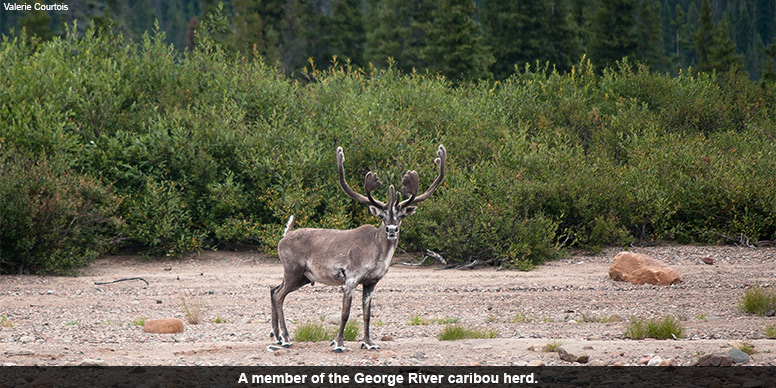
The outcome of the emergency caribou summit on Sunday, April 21, was marked by historic success. The final wording of the mission statement is still being worked out, but the meeting solidifies the first formal relationship between all the aboriginal nations of the Quebec-Labrador Peninsula. A structure for moving forward is now approved, and elected representatives will serve on a roundtable to further important discussions. By coming together, these diverse peoples are demonstrating in their unity just how important the survival of the caribou is to them and their way of life, but also how important they are to the caribou.

Those who attended the emergency summit made clear that aboriginal practices did not cause the peril the caribou now face, but attendees agreed the important first step their communities need to take to save the species is to revivify and reinstitute their cultural code of ethics toward the animal, which many feel has deteriorated over time.
Those at the summit spoke of modernizing their traditional laws relating to the hunt, including those in regard to respect and humility, the utilization of all the parts of the animal, and the taking no more than is absolutely needed. In fact, the Cree nation has already put the practice in place.

There was a great deal of discussion at the summit on increasing protection for the George River herd's calving ground, known here as the “Caribou House,” from industrial pressures such as mining.
But the attendees were also aware of the internal tribal regulation of “take numbers,” which are the number of animals a hunter kills. Such discussions are very sensitive because of aboriginal cultural issues, humility being an important value among aboriginal hunting laws. Hunters do not speak of how many animals they have taken because such talk would be considered bragging and disrespectful to the animal. This reticence makes it difficult to tally total take numbers, but the emphasis on humility and aversion to boasting are important safeguards to overharvesting in and of themselves.
The representatives from all the aboriginal nations of the Quebec-Labrador Peninsula believe any Canadian government-mandated hunting moratorium would be resoundingly rejected by their communities, but many of the nations agreed to self-imposed hunt moratoriums. All of these issues raised at the summit will be further debated at the next meeting, which will take place later this year in Nain, Labrador.

Everyone I talked to at the summit felt the meeting was truly magical—a unifying gift from the caribou spirit. For me, it was yet another confirmation of just how much can be accomplished when diverse people put their differences aside and work together in service of their highest values and aspirations.
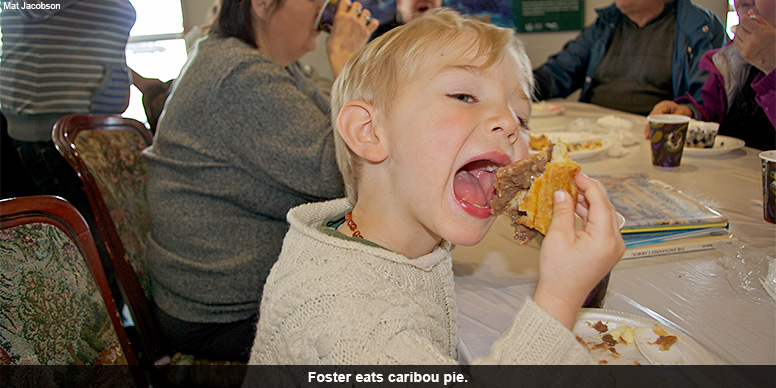
And in the end, Foster did indeed get to eat some caribou, as well as help save some. He liked it, which was a good thing, because it might be some time before he gets to experience this again. I will keep you updated on the progress of the emergency caribou summit. Thanks for reading!
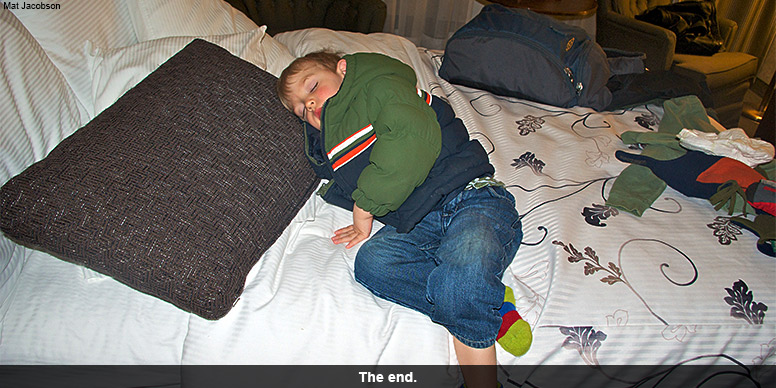

The first day of the emergency caribou summit was extremely productive. Valerie Courtois, the senior advisor on aboriginal relations for the Canadian Boreal Initiative, led the discussions in this historic meeting. A big part of yesterday's successes was due to Valerie's outstanding facilitation skills and commitment to both the environment and aboriginal rights.

For generations, these Aboriginal nations have been exploited by outsiders so when it comes to talks about land and resources, who makes a decision and how it gets made is at least as important as the content of those talks. These aboriginal nations would never allow a non-aboriginal government, or anyone else, to dictate their relationship with the caribou. And in regions like the arctic and subarctic, where resources are scarce, it's not uncommon for distinct cultural groups who compete for those same scarce resources to have adversarial relationships.
Yet each nation realizes that the threat the caribou face is unprecedented. This is why they have put aside their differences to come together and meet. Never before have all the aboriginal nations of the Quebec and Labrador Peninsula joined together in one unified effort to address a common challenge.
Making sure this process is open, transparent, fair, equitable, and affords respect to each aboriginal nation's rights and traditions is critical. All nations must ensure that the others understand their relationship to the herd, and the herd's relationship to their nation, before they can consider entering into anything like a joint effort.
As an Innu, Valerie was able to operate within these cultural and historical dynamics in a way that an outsider couldn't. Case in point: many participants, particularly the elders, will spend what seems to an outsider to be an inordinate amount of time telling their personal story and their relationship to the land and the caribou before getting on to the agenda item. Where an outsider might impatiently to skip these personal stories and get to the program, Valerie knows that they are the program - stories and history here define authority and expertise far more than title. The task at hand will not be accomplished by getting the participants to fill in the blanks on a habitat or species management format written somewhere else – it's going to have to be built here from the ground up by the diverse attendees of this meeting. And the foundation will be the commonality they find in these stories.
By the end of the day, everyone was comfortable enough with each other and the process to move forward to the work of formalizing a relationship and moving forward with discussing specific policy proposals tomorrow.
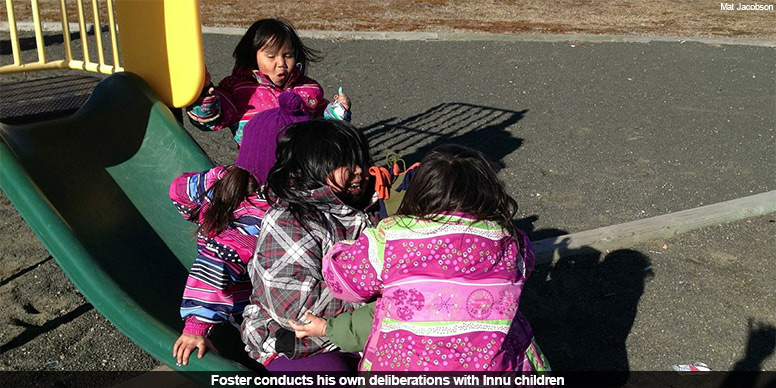
Meanwhile, during the day's deliberations, Foster took some time out to explore the local customs with some Innu more his own age at the local playground.
Valerie is a wonderful moderator, but she's also an outstanding photographer, which gives me a great excuse to get some actual photos of caribou into this Dispatch.

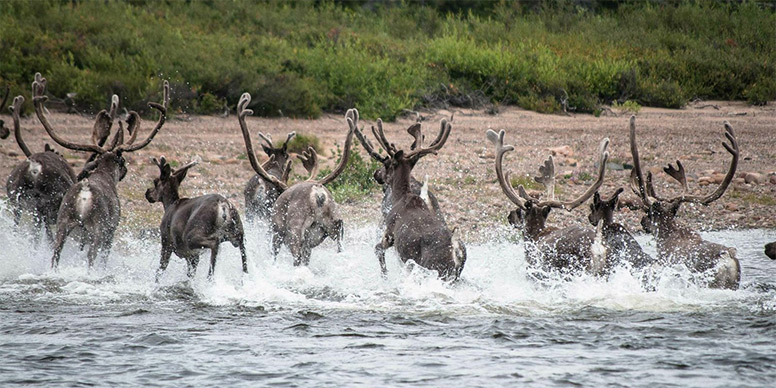
After spending Sunday night on the train, Foster and I spent Monday in the charming town of Rimouski on the south shore of the Saint Lawrence River, swimming, eating crepes, and waiting for the ferry.

That evening we boarded the Nordik Express, a supply ship that transports containers and passengers to a dozen remote ports along the Côte-Nord of the Saint Lawrence in far eastern Quebec.
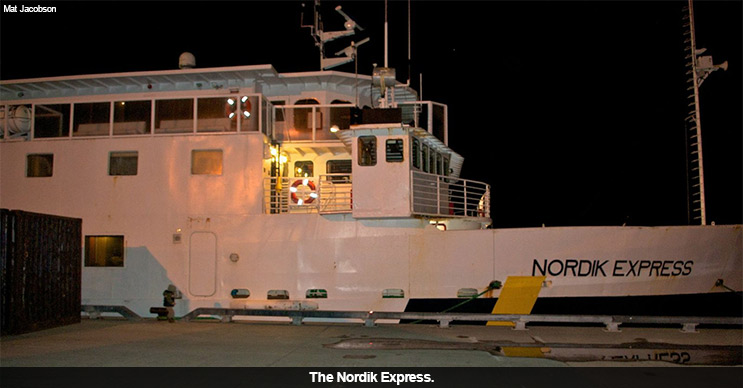
Spending a night on a ship may have been the most exciting part of the trip for Foster, who considers himself a “real pirate.” And it's a good idea to take his word on that. He has informed me with no uncertainty that the only people he ever makes walk the plank are people who don't believe he is a real pirate.
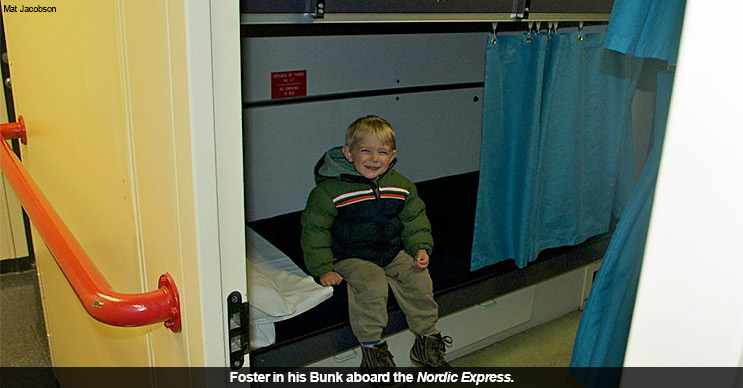
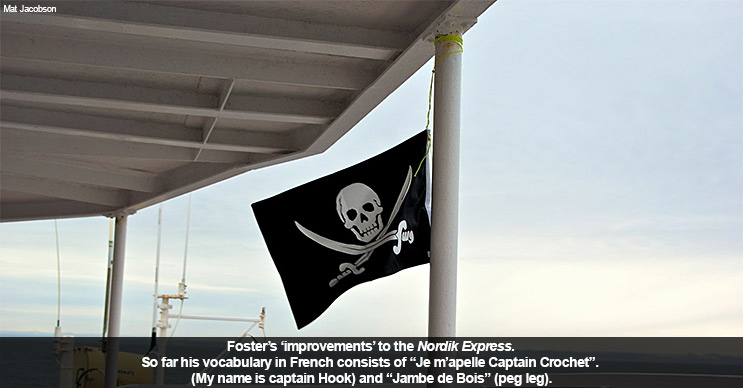
One thing that visitors often note when visiting Quebec province is the omnipresence of Quebec flags—and the near absence of Canadian flags. (This was the case in Rimouski and on our ship, which featured only a Quebec flag until Foster commandeered it and hoisted a Jolly Rodger.) The best way to understand this for an American, I think, is through a lens of nationalism rather than separatism. Quebec is officially recognized by the Canadian government as a “nation within a nation,” meaning that while Quebec is part of the Canadian federation, it is recognized as retaining a distinct cultural identity. This distinctiveness is a critical point of pride for almost all Quebecers, whether or not they favor independence from the Canadian federation.
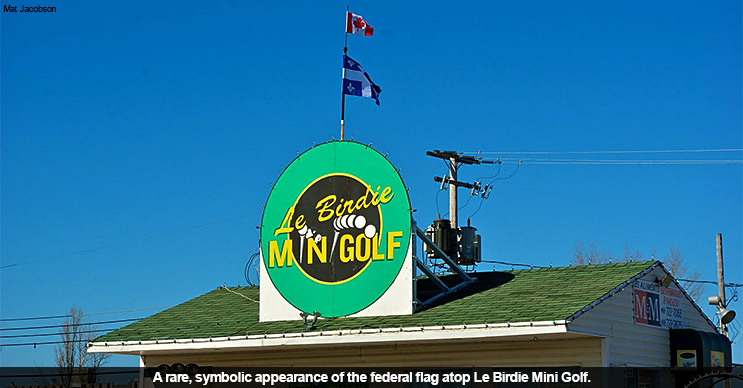
Canada's aboriginal nations, among them the Inuit of Nunavik, the Inuit of Nunatsiavut, NunatuKavut, the Innu Nation, six Innu communities from Quebec, the Naskapi Nation of Kawawachikamach, and the Cree Nation of Eeyou Istchee (the Nations), share this pride in their own identify within the borders of Canada. The meeting my son and I are attending attests to this pride and to their concern about one of their most important cultural components – the the caribou.
At 10 a.m. on Tuesday, we arrived at the port of Sept-Îles and made our way to the Shaputuan Museum on the Innu Uashat Reserve for the meeting. The Innu have lived in northeastern Quebec and western Labrador, which they call Nitassinan (“Our Land”), for thousands of years. Before the 20th century, the Innu were based in the Quebec-Labrador interior for the winter months, where they lived as nomadic hunters, but they came to the coast in summer to sustain themselves on fish, seals, and sea birds.
As logging operations moved into Innu territory beginning in the early 1900s, populations of caribou and other animals the Innu depended on began to decline, forcing many of them to abandon their traditional livelihoods. The Innu were one of the last Canadian aboriginal groups to settle into permanent villages, and they remain fiercely independent and closely tied to their traditional way of life.
Valerie Courtois—the senior advisor on aboriginal relations for the Canadian Boreal Initiative, or CBI, which was established by Pew to support locally based innovative solutions for conserving Canada's Boreal forests—is serving as the facilitator of the emergency caribou summit and is an Innu herself.

Courtois worked closely with Pew and the Canadian Boreal Initiative while serving as forest planner for the Innu Nation. She now informs our work across Canada by providing resources and expertise in land-use planning and identifying opportunities like the caribou summit, where we can support independent efforts by aboriginal communities to lead the way in resolving complex ecological challenges.
The George River caribou herd—the herd at issue during the summit's discussions—was once the world's largest, with a population of three-quarters of a million in the early 1990s. By 2001, the herd had been reduced to 385,000, and it continues to be depleted, falling to 75,000 animals in 2010. The most recent survey measures the herd size at less than 28,000.
Migratory caribou herds, however, historically show dramatic swings in population. For instance, in the late 1940s, the George River herd may have fallen to a perilously low 3,500. In 1958, a careful census estimated the number at 15,000 before the herd rebounded to historic highs at the end of the century.
But when the caribou population decreases to historical lows, as they have recently, there is a higher possibility of unexpected events. Industrial activities such mining and hydroelectric dams were not as prevalent during the previous population lows but these activities can potentially push the population to a point where it can't recover.
Over the next three days, more than 50 chiefs, hunters, biologists, wildlife managers, and elders from seven Canadian aboriginal nations will work to figure out how they can best help this species that is so much a part of their culture, their history, and their lives. This is exactly the kind of leadership that Courtois has helped Pew identify and support in the Boreal forests. It's an honor to be a part of the summit, and she's an inspiration to us all.
My son Foster and I set off on Sunday across Canada to attend this meeting, which starts Tuesday in Sept-Iles, on the north shore of the Gulf of St. Lawrence in Quebec province. We started our trip riding the overnight train from Montreal to Rimouski, on the Gaspe Peninsula at the south side of the great seaway. From there, we took an overnight ferry to Sept-Iles for the meeting.
Foster is very excited. Talking with him about the trip has been a great opportunity for us both to explore the concept of culture, people's relationship to the environment, and the idea of a natural balance. As Foster told the train porter, “Me and my daddy are going on a trip to save the caribou this week. And we're going to eat one, too. But you can't eat too many because then there won't be any left. And then everyone will be sad.”
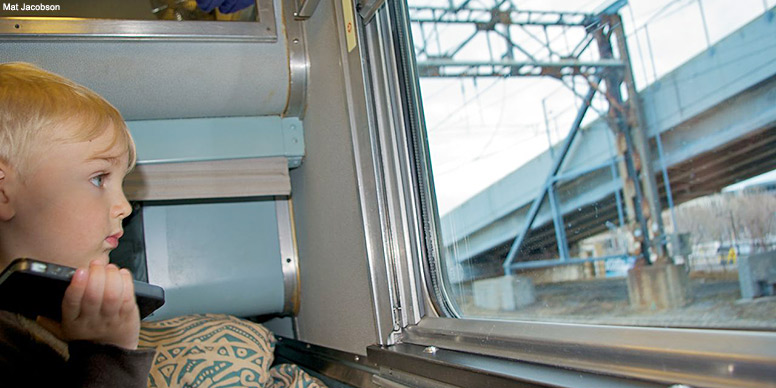
My son's words capture the heart of the problem first aired at the emergency aboriginal caribou summit held in Kuujjuaq, just south of the Arctic Circle, in January this year. It was a historic and uniting event. For the first time, under their own leadership, the Inuit of Nunavik, the Inuit of Nunatsiavut, NunatuKavut, the Innu Nation, six Innu communities from Quebec, the Naskapi Nation of Kawawachikamach, and the Cree Nation of Eeyou Istchee (the Nations) met to explore ways in which they might work together to find solutions to the caribou problem.

These aboriginal nations are spread across northern Quebec and Labrador in Canada's Boreal forests and arctic regions. According to a statement by the participants in the first meeting of the emergency aboriginal caribou summit, this gathering in January marked “the beginning of our united and powerful voice coming together to protect the caribou.” Now, almost three months later, these nations are holding a follow-up meeting to develop a common approach to help save the caribou.
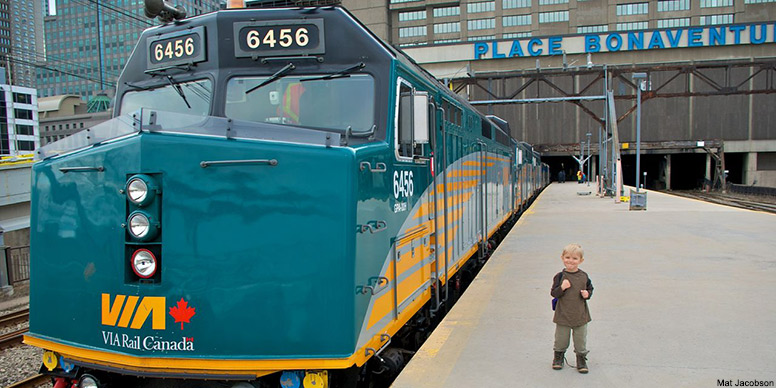
Later dispatches from Foster and me will keep you abreast of the progress made.







